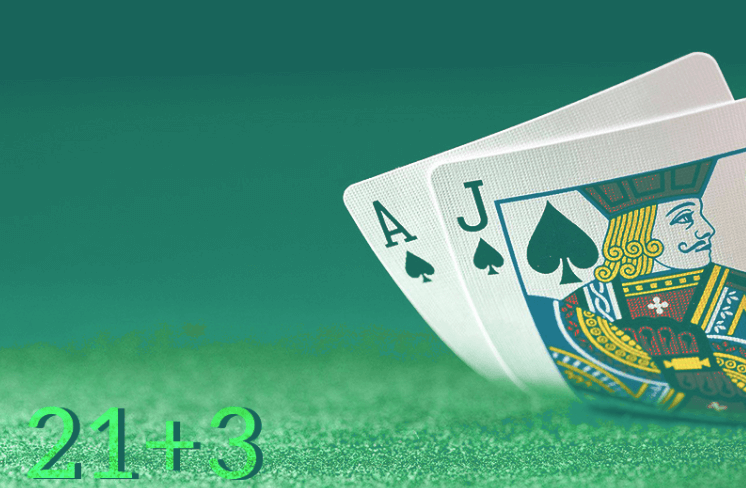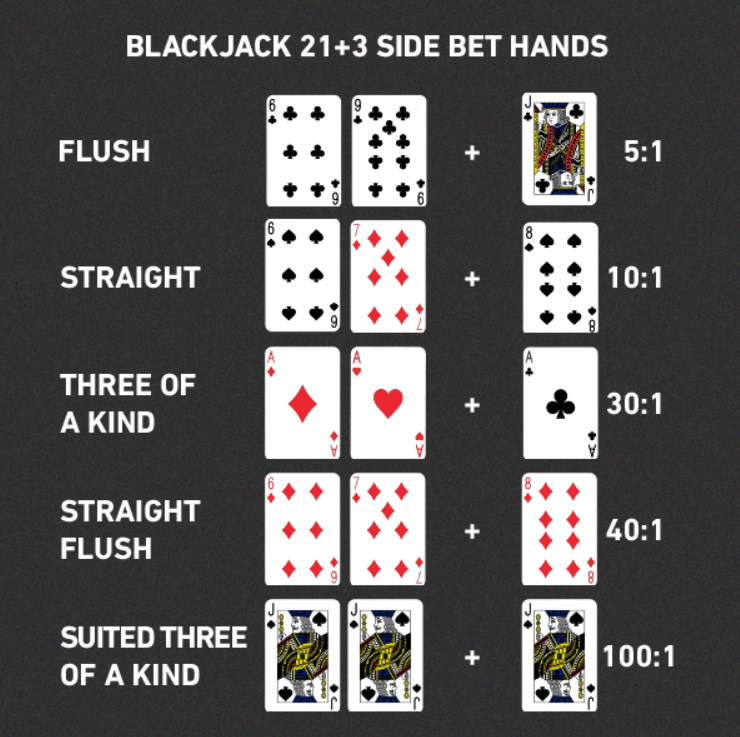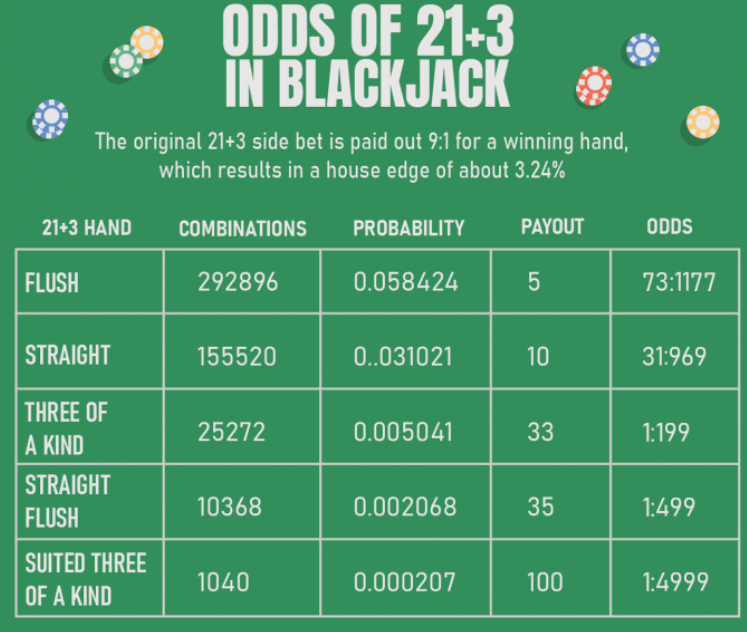Exploring the 21+3 Blackjack Side Bet
May 22, 2023
If you're a blackjack fan seeking an exciting variation to spice up your gaming experience, the 21+3 blackjack side bet might be what you're looking for. This popular side bet combines elements of blackjack and poker, offering players the chance to score big wins while enjoying the familiar thrill of their favorite card game. Read on: His Majesty King Billy, Guardian of the Players, will tell you the answer to the question “What is 21+3 in blackjack?”. From how to play and win big payouts to the pitfalls you should avoid – we'll cover it all.

21+3 Blackjack Side Bet: What Is It?
So, what is 21+3 in blackjack online? At its core, it is an optional wager that hinges on the player's initial two cards and the dealer's upcard, forming a three-card poker hand together. It yields payouts based on specific poker hands combinations, such as flushes, straights, and three-of-a-kinds.
By marrying aspects of blackjack and poker, the bet injects a thrilling new dimension into the game, allowing players to chase sizable payouts while indulging in the traditional blackjack action they cherish.
with any side bet, the 21+3 comes with a unique set of rules and risks that players should know before placing their bets. Therefore, let's explore how to play this side bet and what you can expect regarding payouts.
Blackjack 21+3 Bet: How to Play It?
How does 21+3 work in blackjack? Playing it begins with placing a standard blackjack bet. Once that's done, players can place an additional wager in the designated 21+3 betting area. After placing this extra wager, play proceeds normally with dealing out cards and determining the winner of the main game. Then comes resolving all other hands on the table, including evaluating any 21+3 bets. Players with a qualifying poker hand (as determined by casino rules) will win according to the payout schedule.
The payouts for this side bet vary depending on your poker hand and the specific casino you're playing at. That said, we will provide some standard hands and their payouts below.

Achieving Three of a Kind
A three-of-a-kind occurs when all three cards (the player's two cards and the dealer's upcard) share the same rank, regardless of suit. For example, if you hold a pair of 7s and the dealer's upcard is another 7, you have a three-of-a-kind. The typical payout for this hand is 30 to 1, but it may vary depending on the casino.
Securing a Flush
A flush happens when all three cards share the same suit, such as three hearts or three spades. The rank of the cards does not matter in this case. Flushes generally pay out at 5 to 1, although the specific payout may differ at different casinos.
Landing a Straight
A straight occurs when the three cards form a sequence, such as 4-5-6 or 10-J-Q, irrespective of the suit. Most casinos offer a 10 to 1 payout for a straight, The odds of getting a straight are lower than that for the other qualifying hands, so it's less common but more lucrative when you get one.
Obtaining a Straight Flush
A straight flush is the most potent hand in the 21+3 side bet, featuring both a straight and a flush. In other words, the three cards must share the same suit and form a sequence. For example, a 6-7-8 of spades would be a straight flush. This hand typically pays out at 40 to 1, making it a potentially big win for lucky players.
Odds Associated with the 21+3 Blackjack Side Bet
Understanding the odds associated with this bet is essential for players who wish to make informed decisions and maximize their potential winnings. The odds of landing specific poker hand combinations are influenced by various factors, such as the number of decks used and the specific casino rules.

The approximate coefficients are as follows:
- Flush. 1 in 5 hands
- Straight. 1 in 10 hands
- Three of a kind. in 30 hands
- Straight flush. 1 in 100 hands
It's crucial to remember that the odds presented here are approximate and may vary slightly depending on the specific circumstances of the game.
Payout Structure for 21+3 Blackjack Side Bet
Like for perfect pairs or any other side bet, the payouts for the 21+3 blackjack are contingent upon the specific hand combination achieved. While the payouts can vary slightly between casinos and gaming platforms, the typical payout structure is as follows:
- Flush: 5:1.
- Straight: 10:1.
- Three of a kind: 30:1.
- Straight flush: 40:1.
In addition to the standard payouts, certain casinos and gaming platforms might offer bonus payouts or progressive jackpots for the 21+3 side bet. These additional rewards can be quite enticing, especially when the jackpots grow substantially. However, it's essential to thoroughly examine the odds and payouts associated with such bonuses, as the increased house edge may offset any potential gains.
21+3 Blackjack House Edge Explained
The house edge for the 21 plus 3 blackjack side bet typically ranges from 3% to 7%. It is higher than the main blackjack game, which usually ranges from 0.5% to 2% with optimal strategy. The increased house edge means that the 21+3 side bet presents a riskier proposition for players, and long-term success in this side bet may be challenging.
The appeal of the 21+3 blackjack side bet lies in its potential for significant payouts and the added excitement it brings to the game. Players willing to accept the higher house edge and embrace the element of chance may find the 21+3 side bet an enjoyable addition to their blackjack experience. Responsible bankroll management and a clear understanding of the odds and payouts associated with the side bet are crucial to ensure a positive gaming experience.
It's worth considering that the house edge for the 21+3 side bet can be influenced by factors such as:
- Payout structure. Casinos that offer more generous payouts for specific hand combinations will have a lower house edge. So, always check the payout table to assess the potential returns on your wager.
- The number of decks. The number of decks in play can also impact the house edge for the 21+3 bet. Generally, a higher number of decks will result in a slightly lower house edge, although the difference may not be significant.
- Rule variations. Some games may implement unique rules for the side bet that can impact the house edge. For example, a casino might require the dealer to hit on a soft 17, increasing the house edge for the side bet.
In conclusion, the 21+3 blackjack side bet offers an exciting and potentially lucrative twist to traditional blackjack gameplay. By understanding the answers to the questions “What does 21+3 mean in blackjack?”, “What are its odds and payouts?”, and “What is its house edge?”, players can make informed decisions and tailor their gaming experience to their preferences and risk tolerance. So, if you're in the mood for a thrilling game of chance with the potential for big payouts, give the 21+3 blackjack side bet a shot – and may the odds be in your favor!
FAQ
Is 21+3 a standard feature in blackjack games?
No, 21+3 blackjack is not a standard feature in all blackjack games. It is an optional side bet in some casinos and online gaming platforms. Its availability depends on the specific casino and the variation of the game you are playing. Always check the table rules to see if 21+3 blackjack is offered.
Can card counting techniques be applied to the 21+3 blackjack bet?
Card counting techniques can apply to the 21+3 blackjack side bet when playing in land-based casinos, meaning it can be quite profitable. However, in online versions, the deck is usually continuously reshuffled between rounds to prevent card counting. So, card counting is not an effective strategy when applying the 21+3 blackjack bet online.
Do seasoned blackjack players often opt for the 21+3 bet?
Seasoned gamblers may occasionally participate in the 21+3 side bet for the excitement and the potential for higher payouts. However, many experienced players tend to focus on the main blackjack game, as it typically offers a lower house edge and a better opportunity for strategic play. The decision to play the 21+3 blackjack depends on the player's preferences, risk tolerance, and bankroll management strategy.
< Back to the blog










